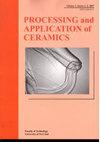cu掺杂ZnO纳米花的绿色发光性能增强及抗菌活性提高
IF 0.8
4区 材料科学
Q3 MATERIALS SCIENCE, CERAMICS
引用次数: 1
摘要
采用共沉淀法制备了铜掺杂ZnO (CuxZn1-xO, x = 0,0.01, 0.02, 0.04, 0.05)纳米花。通过x射线衍射分析证实了纯铜和掺铜样品的六方纤锌矿纳米晶相。场发射扫描电镜结果证实了cu掺杂ZnO中出现了完全分散的纳米花状形貌和均匀分散的颗粒。利用Tauc?年代的阴谋。所有生成的样本?室温光致发光光谱显示两个发射峰,一个激子峰在紫外区,另一个宽缺陷能级峰在可见光区。通过可见光区PL光谱分析了纯样品和掺杂样品的黄色和绿色发光特性,使其适合光电应用。对制备的纳米结构对粪肠球菌(革兰氏阳性)和铜绿假单胞菌(革兰氏阴性)的抗菌潜力进行了评估。与纯ZnO纳米结构相比,掺杂样品的抗菌活性增强。对于含有5个at的样品。%Cu,对铜绿假单胞菌的最大抑制区为25mm。对于掺杂5at的样品。% Cu,对粪肠球菌的最大抑制区为21mm。结果表明,所得样品对革兰氏阴性菌的抑菌潜力高于革兰氏阳性菌。因此,所制备的掺杂ZnO纳米花被推荐为生产白光led和有效的抗革兰氏阴性菌纳米抗生素的优秀绿色纳米荧光粉。本文章由计算机程序翻译,如有差异,请以英文原文为准。
Enhanced green luminescence properties of cu doped ZnO nano-flowers and their improved antibacterial activities
The copper doped ZnO (CuxZn1-xO, where x = 0, 0.01, 0.02, 0.04, 0.05) nanoflowers were produced by using co-precipitation process. Hexagonal wurtzite nanocrystalline phase of both pure and Cu-doped samples was confirmed by X-ray diffraction analysis. Field emission scanning electron microscopy results confirmed the emergence of fully dispersed nanoflower like morphologies in the Cu-doped ZnO and uniform dispersion of particles. Band gap energies of the prepared samples were calculated using the Tauc?s plot. All of the generated samples? room temperature photoluminescent spectra show two emission peaks, one excitonic peak in the UV region and another broad defect level peak in the visible area. The yellow and green luminescence characteristics of both pure and doped samples were analysed via the PL spectra in visible light region, making them appropriate for optoelectronic applications. The antibacterial potential of the produced nanostructures against the bacterial strains of Enterococcus Faecalis (gram positive) and Pseudomonas Aeruginosa (gram negative) were assessed. When compared to the pure ZnO nanostructures, the doped samples exhibit enhanced antibacterial activity. For the samples with 5 at.%Cu, the greatest zone of inhibition against Pseudomonas Aeruginosa was noted to be 25mm. For the samples doped with 5 at.% Cu, the largest zone of inhibition against Enterococcus Faecalis was 21mm. The findings indicate that the obtained samples have higher antibacterial potential against gram negative than gram positive bacteria. The prepared doped ZnO nanoflowers were therefore recommended as excellent green nanophosphors for the production of white LEDs and effective nanoantibiotics against gram-negative bacteria.
求助全文
通过发布文献求助,成功后即可免费获取论文全文。
去求助
来源期刊

Processing and Application of Ceramics
MATERIALS SCIENCE, CERAMICS-
CiteScore
1.90
自引率
9.10%
发文量
14
审稿时长
10 weeks
期刊介绍:
Information not localized
 求助内容:
求助内容: 应助结果提醒方式:
应助结果提醒方式:


